
Grades 9-12

Don't have an account yet? Sign up for free
Don't have an account yet? Sign up for free

Does your family follow any customs or traditions? You shouldn’t have to think to hard to come up with a few. 
Do you have your own seat at the kitchen table where you nearly always sit? Do you receive birthday gifts? If you answered yes to either of these questions, you have customs and traditions in your home. Of course, religions and nations also have customs and traditions. What do people do on the Fourth of July? What kind of music is played on the radio in the month of December?
Did you know that in some countries customs and traditions shape the entire economic system. This kind of an economy is called a traditional economy. A traditional economy is one in which the allocation of resources and other economic activity are based on ritual, habit, or custom. Farming, hunting and gathering have been done the same way for generations, and economic activities are generally centered around the family unit. Technology is not embraced, and gender roles are clearly defined. Within these economies, individual people do not make economic decisions. Instead, tradition predetermines decisions.
In the ancient world, places like Mesopotamia and Sumeria, traditional economies were the norm. While a traditional economy may seem like something we would only read about in history books, there are still some remote places in the world where a traditional economy is the accepted way of life. Traditional economies are still found in many developing countries- in parts of Africa, Asia, South America, and the Middle East.
The Inuit of northern Canada provides an example of a traditional economy. For thousands of years, Inuit parents have been teaching their children the survival skills that they need to survive in the severe climate of the Arctic Circle. The children are taught how to fish, hunt, and make traditional tools. Once learned, these skills are passed down to the next generation.
 When the Inuit hunt, it is traditional for them to share the kill with other families in the community. If a walrus or bear is caught, hunters divide it evenly into as many pieces as there are heads of families in the hunting party. The hunter most responsible for the successful hunt has first choice, the second-most helpful hunter chooses next, and so on. Because of this custom of sharing, as long as skilled hunters live in the village, the Inuit survive the long, cold winters with the food and goods they need. This is a prime example of how life works in a traditional economy.
When the Inuit hunt, it is traditional for them to share the kill with other families in the community. If a walrus or bear is caught, hunters divide it evenly into as many pieces as there are heads of families in the hunting party. The hunter most responsible for the successful hunt has first choice, the second-most helpful hunter chooses next, and so on. Because of this custom of sharing, as long as skilled hunters live in the village, the Inuit survive the long, cold winters with the food and goods they need. This is a prime example of how life works in a traditional economy.
Does this sound like a way of life that you could would like to try? Can you imagine living in a society in which you would not decide what you would do to earn or spend money? In this lesson, you will learn more about the Inuit’s traditional economy and compare it to our own market economy. You will consider costs and benefits associated with both traditional and free market economic systems.
Respond to the questions on the worksheet entitled, “Learning about the Inuit.”
Discuss your research and the information on your Venn Diagrams with your classmates.
What have you learned about the differences between traditional and market economies? What were the similarities? What have you learned about the Inuit people? Did you find any evidence that their traditional economy is changing? If so, what did you find, and how is it changing? Do you think this will have a positive or negative effect on the Inuit community? Why?
Evaluate the traditional economy of the Inuit. Do you think that this is an effective way for the Inuit to live? Do you think that the United States could survive economically with a traditional economy? What would have to change for that to occur?
Finally, knowing what you know now, write an editorial offering your perspective on the Inuit and on traditional economies.
Using the information you have learned, provide this information:
Research to find other modern-day examples of traditional economies.
With your classmates, develop a skit based on what you have learned about traditional or market economies. Try to get your peers to guess which type of economy your skit portrays.

Grades 9-12

Marginal Revolution University
Grades 9-12

Grades 9-12

Content Partner
Grades 3-5
